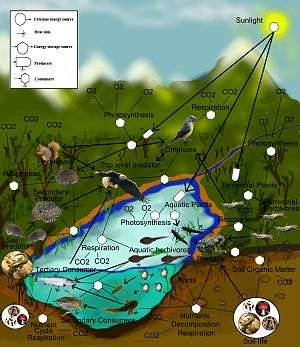Consumer (food chain)
Consumers are organisms of an ecological food chain which receive energy by consuming other organisms. These organisms are formally referred to as heterotrophs, which include animals, bacteria and fungi. Such organisms may consume by various means, including predation, parasitization, and biodegradation.
Classification
Consumers are typically viewed as predatory animals such as the wolf and hyena. However, herbivorous animals and parasitic fungi are also consumers. Some carnivorous plants, like the Venus flytrap, are classified as both.[1]
Levels

Within an ecological food chain, consumers are categorized into three groups: primary consumers, secondary consumers, and the tertiary consumers.[2] Primary consumers are usually herbivores, feeding on plants and fungus. Secondary consumers, on the other hand, are mainly carnivores, and prey on other animals. Omnivores, who feed on both plants and animals, can also be considered a secondary consumer. Tertiary consumers, sometimes also known as apex predators, are usually at the top of food chains, capable of feeding on secondary consumers and primary consumers. Tertiary consumers can be either fully carnivorous or omnivorous. Humans are one such example of a tertiary consumer.
Importance to the ecosystem
Consumers dominate most parts of an ecosystem. Consumers have important roles to play within an ecosystem such as balancing the food chain by keeping animal populations at a reasonable number. Without proper balance, an ecosystem can collapse and cause the decline of all affected species. This will lead to a severely disrupted ecosystem and a nonfunctional consumer web.
See also
References
- ↑ "Venus flytraps' carnivorous ways enable it to do photosynthesis better". Cornell Center for Materials Research. 5 March 2008. Retrieved 9 February 2012.
- ↑ http://www.usoe.k12.ut.us/curr/science/sciber00/8th/energy/sciber/chains.htm